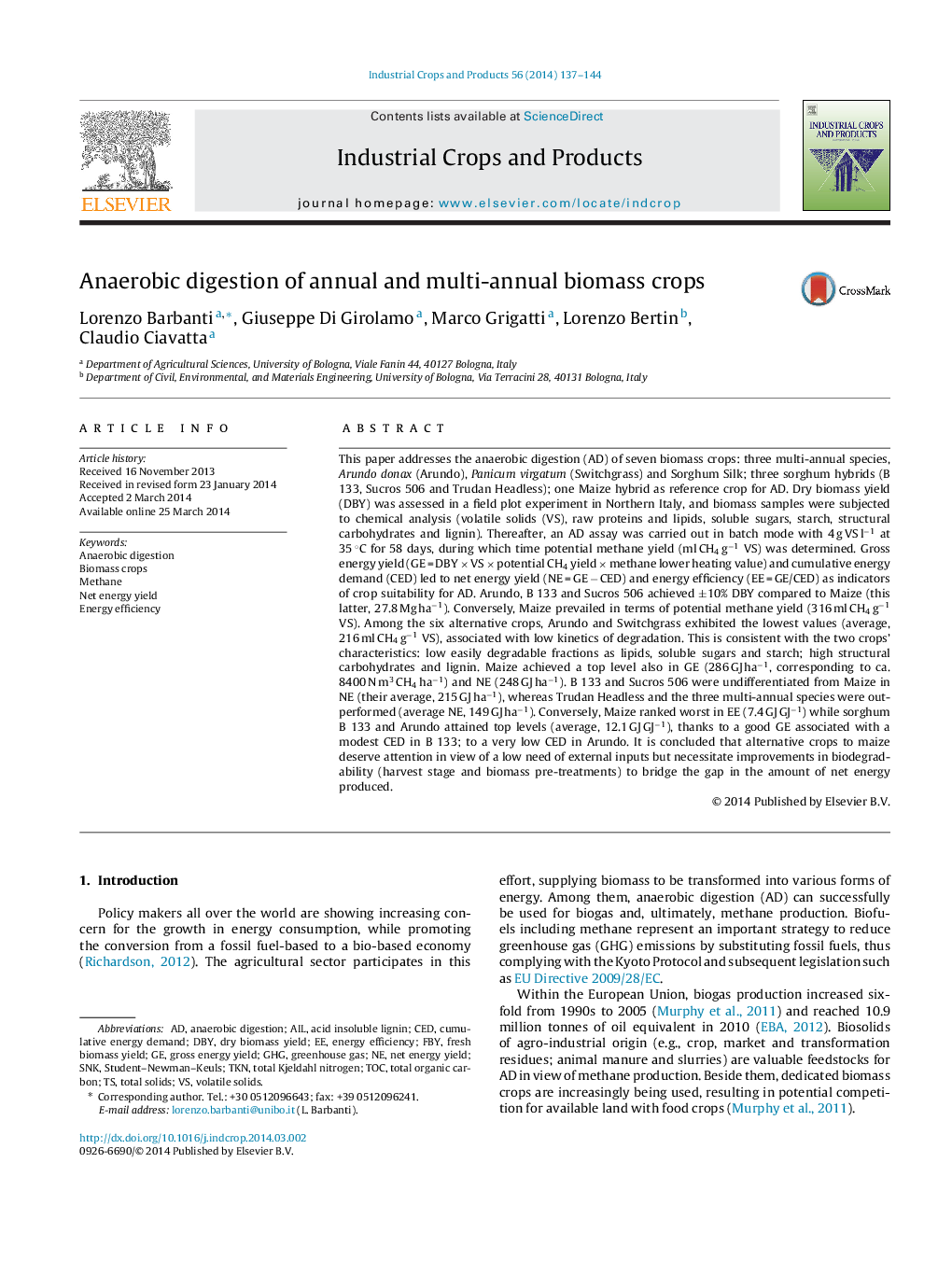| کد مقاله | کد نشریه | سال انتشار | مقاله انگلیسی | نسخه تمام متن |
|---|---|---|---|---|
| 4513311 | 1624853 | 2014 | 8 صفحه PDF | دانلود رایگان |
• We compared seven annual and multi-annual biomass crops in view of methane production.
• Potential CH4 yield in batch incubation assay ranged between 216 and 316 ml g−1 VS.
• Maize prevailed in net energy yield (248 vs. 171 GJ ha−1 average six alternative crops).
• Arundo, Switchgrass and biomass sorghum prevailed over maize in energy efficiency.
• Enhanced biodegradability is needed to improve alternative crops competitiveness.
This paper addresses the anaerobic digestion (AD) of seven biomass crops: three multi-annual species, Arundo donax (Arundo), Panicum virgatum (Switchgrass) and Sorghum Silk; three sorghum hybrids (B 133, Sucros 506 and Trudan Headless); one Maize hybrid as reference crop for AD. Dry biomass yield (DBY) was assessed in a field plot experiment in Northern Italy, and biomass samples were subjected to chemical analysis (volatile solids (VS), raw proteins and lipids, soluble sugars, starch, structural carbohydrates and lignin). Thereafter, an AD assay was carried out in batch mode with 4 g VS l−1 at 35 °C for 58 days, during which time potential methane yield (ml CH4 g−1 VS) was determined. Gross energy yield (GE = DBY × VS × potential CH4 yield × methane lower heating value) and cumulative energy demand (CED) led to net energy yield (NE = GE − CED) and energy efficiency (EE = GE/CED) as indicators of crop suitability for AD. Arundo, B 133 and Sucros 506 achieved ±10% DBY compared to Maize (this latter, 27.8 Mg ha−1). Conversely, Maize prevailed in terms of potential methane yield (316 ml CH4 g−1 VS). Among the six alternative crops, Arundo and Switchgrass exhibited the lowest values (average, 216 ml CH4 g−1 VS), associated with low kinetics of degradation. This is consistent with the two crops’ characteristics: low easily degradable fractions as lipids, soluble sugars and starch; high structural carbohydrates and lignin. Maize achieved a top level also in GE (286 GJ ha−1, corresponding to ca. 8400 N m3 CH4 ha−1) and NE (248 GJ ha−1). B 133 and Sucros 506 were undifferentiated from Maize in NE (their average, 215 GJ ha−1), whereas Trudan Headless and the three multi-annual species were outperformed (average NE, 149 GJ ha−1). Conversely, Maize ranked worst in EE (7.4 GJ GJ−1) while sorghum B 133 and Arundo attained top levels (average, 12.1 GJ GJ−1), thanks to a good GE associated with a modest CED in B 133; to a very low CED in Arundo. It is concluded that alternative crops to maize deserve attention in view of a low need of external inputs but necessitate improvements in biodegradability (harvest stage and biomass pre-treatments) to bridge the gap in the amount of net energy produced.
Journal: Industrial Crops and Products - Volume 56, May 2014, Pages 137–144
